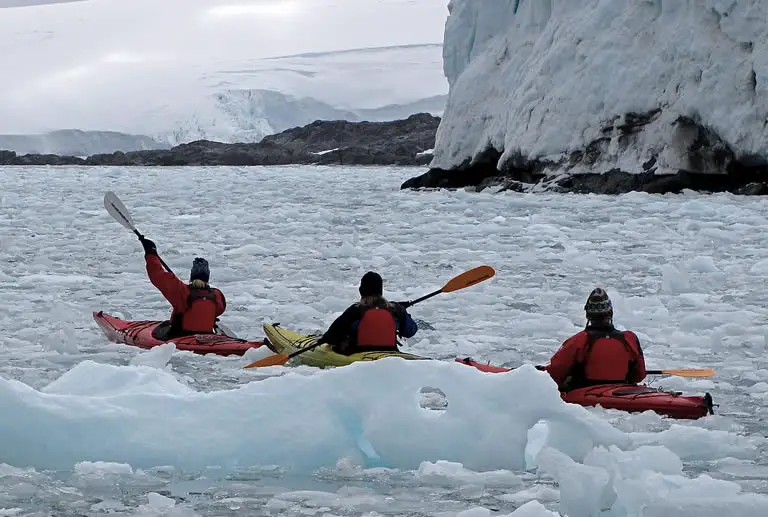We all know that summer kayaking can be a lot of fun but is it just as fun to kayak in the winter?
Contents
- Can You Kayak In The Winter Safely?
- Challenges Of Winter Kayaking
- How To Stay Warm While Kayaking In The Winter Months
- Essential Winter Kayaking Equipment
- It begins with the right kayak
- Use body protection
- Wear a wetsuit or drysuit or both
- Headwear is helpful for keeping warm
- Ear protection is an often overlooked essential
- Hand protection is a must
- Feet protection is non-negotiable
- A personal flotation device can be a lifesaver
- A sprayskirt can help avoid a soaking
- 12 Top Tips For Winter Kayaking
- Summary: How To Kayak In Winter The Safe Way
Can You Kayak In The Winter Safely?
You can kayak in the winter.
However, you need to ensure you have the correct boat equipment and safety gear and have made adequate preparations before setting out.
Kayaking in the winter involves risks to kayaking in the summer but also offers additional rewards.
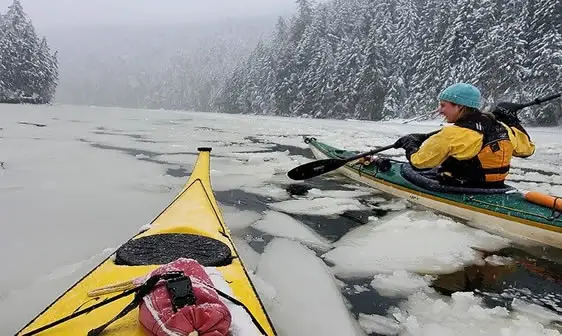
Kayaking in the winter can be thought of as returning to the roots of kayaking.
Winter kayaking was originally taken up by Eskimos, many generations ago, as a means of hunting and fishing on the icy waters while remaining both quick and agile.
But what do you need to know about winter kayaking in order to pursue this activity safety and in a fun way?
Let’s explore.
Challenges Of Winter Kayaking
Kayaks were used extensively in North America, by Native American Nations, in both the summer and winter months.
Although a very versatile all-year-round watercraft, winter kayaking was largely favored by Eskimos.
They used kayaks in the winter for hunting, primarily for the ability a kayak offered to sneak up on prey, thus enabling the hunter to successfully launch his attack under stealth.
Traditionally made of driftwood, or whale skeletons, the Kayak’s structure has always remained simple, yet effective.
The skin of the craft came from animal skin with preference given to the waterproof skin of seals.
This design made the kayak a very successful watercraft for fishing, hunting and transportation all year-round.
However, in the winter months the design of a kayak did, and still does, bring with it its own challenges.
By nature, the kayak keeps the rower’s body very close to the water.
This means in particularly cold temperatures, the paddler is surrounded by cold temperatures.
Thus, in cold waters and cold weather temperatures a kayaker is using a lot of energy in order to simply generate enough body heat to stay warm.
With tougher, more challenging extremes of cold in some winter climates, kayakers will find performing even simple actions difficult.
It can be a very different prospect doing even simple tasks in cold conditions than it is doing the same things in warmer seasons or even under moderately cold conditions.
The differences between warm-weather kayaking and winter kayaking, and the challenges it brings, should not to be underestimated, even by the most experienced of summer kayakers.
If you have never kayaked outside of moderate temperate settings then it’s worth getting a solid briefing on what to expect from kayaking in the winter.
Preparation is key
The key limitations to bear in mind when kayaking in the winter are those connected to the limitations of your own abilities, as well as the limitations of your equipment.
Ask yourself some sensible questions before venturing out onto winter waters.
Questions like:
- Is your kayak designed for the uses you have in mind? This is always an important question to ask (as we pointed out in the article about the dangers of kayaking) but it is never more important than it is in the winter.
- Do you have the necessary experience to tackle the water and weather?
- Do you have the correct gear for such an excursion?
- Is your gear of the sufficient quality to tackle the cold waters and cold weather?
If you can answer “yes” to the above questions you are good to go.
What are the advantages of winter kayaking?
Before we venture into the real challenges of winter kayaking, and how to prepare yourself to meet those challenges, we should have a quick look at some of the many benefits of kayaking in the winter months.
It isn’t all gloomy weather and freezing temperatures!
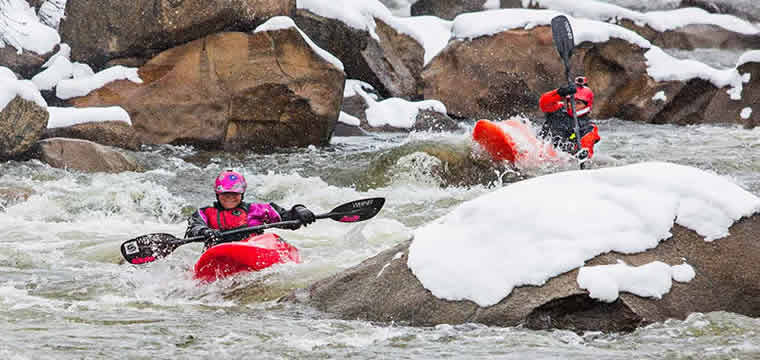
There are definite perks to going on a kayaking outing during the winter.
Here are just a few:
- There are no crowds: Cold weather keeps weekend warrior kayakers off the water. Basically, the adverse weather conditions keep the crowds away. So with only dedicated kayakers out on the water you can enjoy the bliss of having the pick of the waters and having them all to yourself.
- The scenery is amazing: In the winter you get to see the natural environment in an entirely different way. Snow-covered landscapes and frozen courses make for delightful viewing. The natural beauty of fjords, glaciers, caves and cliffs, in Nordic climes for example, are all enhanced by the wintery backdrop. Even waterways at home, that you may be very acquainted with in the summer, take on a new feel and look in the winter.
- There is winter wildlife: In the winter you can often see wildlife close-up in ways that would never be available in warmer months due in part to the lack of human activity. Depending on the location you could see unusual marine life, birds of prey and cold water fish.
- Kayaking is more challenging: Both the climate and the marine environment tend to directly oppose your physical efforts in winter weather. When the wind picks up you may even begin to question your initial decision to even be on the water. Less traction for your feet on river banks, if out boat camping, coupled with the extreme cold of the air and cold of the water present a steep challenge for your body to overcome. You’ll find your body core has a deeper baseline to work from, this simply requires much more metabolic output compared with milder conditions.
How To Stay Warm While Kayaking In The Winter Months
Don’t underestimate the amount of additional energy your body requires when winter kayaking.
Your body will use large amounts of energy reserves just in trying to stay warm.
Your body naturally defends its core temperature of 37 degrees Celsius (98.6 degrees Fahrenheit).
If external conditions threaten your core body temperature, your body will shut-down some regulatory functions to reverse the loss of heat.
The response to this shutdown involves shivering – which is an involuntary mechanical reflex that is thermogenic or heat releasing.
Shivering depletes your energy reserves.
So, it is important to stay warm when kayaking on winter waters.
Let’s see how you can do that effectively without having to bulk yourself up to the point where you look like the Michelin man.
Use layering
Even nature teaches us about the use of layers for heat retention; a bird’s feathers provide natural insulation against the cold.
This helps the bird maintain its core body temperature.
In the same fashion, wearing multiple layers in cold conditions reduces our body’s natural dependence upon raising metabolic activity (energy consumption).
Such heat-trapping assistance will increase your ability to focus on your paddling.
Consider Merino wool
I know that normal wool is a fiber that a kayaker should avoid, (because it acts like a sponge as we pointed out here), but Merino wool is a little bit different.
Merino wool belongs to a specific breed of sheep which goes by the same name – Merino sheep.
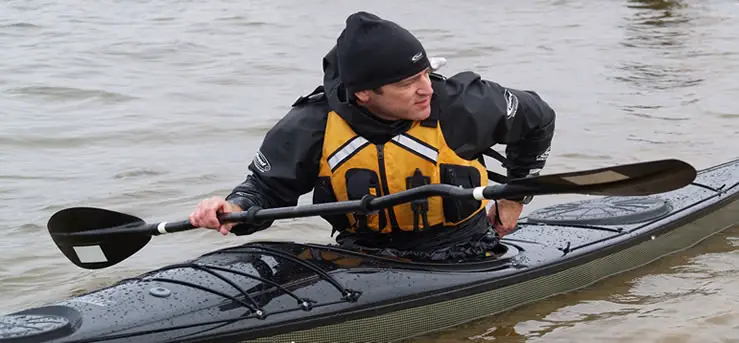
This type of wool has unique qualities that make it more suited for us to wear while kayaking than other types of wool.
Merino wool is gaining some traction in the kayaking world (especially in Scotland where winters can be more than just chilly) because of its unique properties.
To understand the difference between Merino wool and other types of wool like look at the qualities of each.
Properties of common wool that make it unappealing to a kayaker, especially as a baselayer, are:
- It’s itchy.
- It can feel heavy.
- It is bulky and constraining to free movement.
- It makes you sweat.
- It absorbs water like a sponge.
These problems do not exist with Merino wool.
Here are a few facts which make Merino wool baselayers a must-have insulation for kayaking in winter:
- It is breathable allowing moisture from sweat to escape thus keeping you drier. This is referred to as moisture wicking.
- It help retain heat but being breathable it also acts as a heat regulator.
- It is lightweight.
- It is thin and somewhat flexible and thus allows for ease of movement.
- It is soft to the touch and non-itchy which makes it great as a next-to-the-skin material (though you should really wear a wetsuit next to your skin).
- It is a crimped fiber that has better heat-trapping.
- It is odor resistant because it is bacterial resistant (bacteria causes odours).
- It is elastic which means it not only promotes free movement but keeps its shape even after extensive use.
Stay on the move
Staying still drops the core body temperature and is a quick way of allowing negative conditions to begin to take effect.
Movement is a great ally of every kayaker in wintertime because it generates heat.
Whenever you take a pause, it pays to be conscious of your consistent need for thermogenesis (heat release).
On land this means jogging on the spot, or doing something physical that maintains continuous movement, so as to not give-in to the invasive nature of the extreme cold.
On the water this means continually paddling!
Stay energized
Another response to the cold is the burning of stored brown fat.
Brown fat can be thought of more as muscle (white fat is the stuff which makes you chubby) so burning it up isn’t necessarily a good idea!
Both shivering and brown fat depletion are considerable expenses to the body’s energy budget.
Therefore, you must also account for this loss and the toll it will take on your physical performance when preparing to kayak in winter.
You should therefore keep energy bars with a good combination of protein, fat, fiber and carbohydrates on your person so you can quickly replace lost energy while on-the-go.
Stay away from soda and other sugary drinks which may give you a quick energy spike but will cause you to crash in the long run.
They will also dehydrate you which could lead to mental confusion and extreme tiredness.
Stay hydrated
Hydration is important when kayaking in any season.
It is even more important in the winter, when dehydration can affect your decision making abilities and severely lower your energy levels leading to dangerous situations.
As we have seen winter kayaking comes at the cost of energy due to exerted effort. But the extra effort you expend will also cause a loss of water in the body.
The extra clothing you wear in winter can also cause you to sweat more which will then result in more body moisture being lost.
It is vitally important you stay hydrated while kayaking in the winter.
Hydrating with the proper type of cold drinks
When it comes to proper hydration a bottle of water, or water-filled water canteen, will probably suffice.
However, it is a good idea to add some electrolytes, in the form of tablets or powder, to the water. This will help restore the sodium, potassium, chloride, calcium, magnesium, phosphate and bicarbonate that your body loses through sweating.
Staying away from soda does not only help maintain your energy levels but avoiding the sugar in the drink will keep you hydrated longer.
Sugar particles suck water from your body’s cells quickly depleting your body’s water supplies.
Hydrating with the proper type of hot drinks
You can also consider exchanging your water canteen for a thermos with a hot drink, or you can take both.
A hot drink is not only an effective way to stay hydrated but it will directly heat your body thus helping to main your core temperature better in cold conditions.
Avoid hot drinks that dehydrate you though.
Hot drinks that dehydrate you include:
- Tea.
- Coffee.
- Anything with caffeine in it.
- Anything with sugar in it.
Hot drinks that hydrate you include:
- Hot chocolate (must be sugar-free).
- Herbal tea.
- Warm milk (sugar-free vegan milk or cow’s milk).
- Warm water with lemon and honey or sugar-free maple syrup (avoid agave nectar as a substitute for honey as its very high is fructose).
Essential Winter Kayaking Equipment
Good quality kayaking equipment, which performs consistently under all conditions, is essential for safe winter kayaking.
When kayaking in the winter, you never want to encounter kit failure.
It will only compromise your ability to perform properly.
If the weather turns bad and the water becomes challenging you will need all the advantages that you can get.
So, you need gear that is appropriate to the conditions and environment.
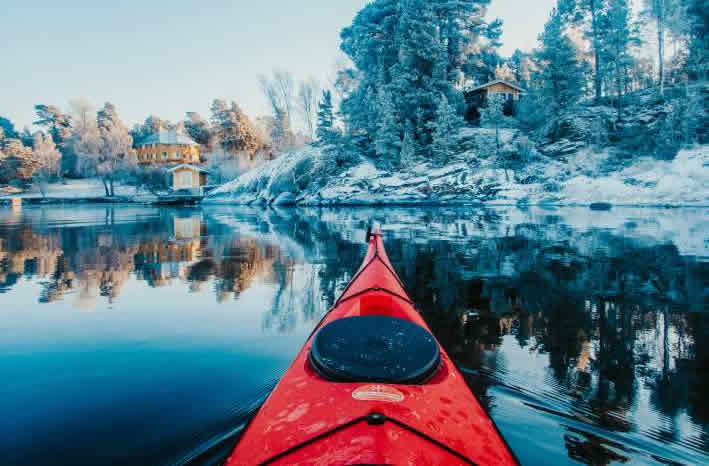
If you intend to kayak at night as well then be sure to read our guide on doing that as there are legally required additions you need to make to your kayak.
Also be aware that temperatures are considerably lower at night than they are in the day so take appropriate precautions in regards to staying warm.
You may need additional layers and protection for your face.
It begins with the right kayak
I know this sounds like kindergarten advice but you’d be surprised by how many beginners miss the following – a kayak which is perfect for an environment in summer months may be totally unsuitable for the same environment in the winter.
You must therefore ensure your kayak is designed for your winter kayaking purposes.
Of course it is not always the case that your normal kayak will not do for winter use but you need to double-check just in case.
Seek expert advice and ensure the kayak you are intending to use is suitable for your purposes.
Use body protection
Body protection starts with your baselayers.
Baselayers refer to the next-to-the-skin clothing protection which is your first line of defense against the cold.
Base layers should have the advantage of being snug fitting and should be thin enough to allow a full range of movement.
And, of course, your baselayer should insulate against the cold.
Doing the job of trapping natural body heat directly against the skin, proper baselayers will add a large degree of comfort through simple heat efficiency.
However, as you are winter kayaking it is a good idea to ensure your baselayers also protect against the cold of the water should you fall in. Shock and hypothermia can be a killer!
Wear a wetsuit or drysuit or both
Both wetsuits and drysuits are designed to keep you warm but the main difference between them lies in the materials used to make them, their functionality and how they are worn.
A wetsuit
is a tight-fitting, baselayer garment that is worn next to the skin. It is designed to keep you warm when you enter cold water.
A wetsuit is not waterproof.
Due to the coldness of the water in winter, wearing a wetsuit is highly advisable while kayaking in the winter months. It will not only help to keep you warm while in your kayak but it will protect you against shock and hypothermia should you go overboard, have to roll or capsize your kayak.
A drysuit
is also designed to keep you warm but is somewhat different from a wetsuit in how it functions.
A drysuit is completely waterproof and fits loosely over your other layers like motorcycle protective coverings.
A drysuit, as the name suggests, will keep you completely dry whilst kayaking in cold water conditions. No cold water, no chill factor.
The keyword when it comes to drysuits is integrity. Maintain the integrity of the fabric and you keep out the cold. Damage it, and it’s rendered useless.
Goretex is a specialist, man-made textile with liquid repelling qualities, whilst being simultaneously permeable to spot moisture. It is lightweight, waterproof and ideal for all weather conditions.
With a drysuit, no matter the material, you must still wear warm clothing underneath – but as a shell, it is designed to lock in the warmth and keep out water.
Gortex is the ideal material for drysuit construction.
Rubber neoprene is the ideal material for a wetsuit.
Headwear is helpful for keeping warm
Head protection is a key safety item when kayaking not just for insurance against the risk of a rock collisions on the shoreline or rapids, but also to prevent head injury from your own equipment.
Many a beginner, rocked by a rogue wave or by simply losing stability, has experienced being hit in the head by either a stray paddle or even their own kayak.
Wear a hard helmet
.
For heat insulation, a skull cap is your best bet. Neoprene works well.
It forms a next-to-the-skin waterproof layer and one that traps heat effectively also.
Ear protection is an often overlooked essential
Yes it’s a thing!
When kayaking in extremely cold water, especially with frequent rolling, the cold can cause a sense of disorientation and dizziness.
Earplugs seem to be the only practical defense against this problem.
Hand protection is a must
For the ultimate combination of handling and comfort using pogies is the general consensus view among experienced kayakers.
Pogies are custom Neoprene coverings for your hands which perform the dual duty of:
- Keeping out the ice-cold wind and water spray.
- Allowing direct contact between your hand and the paddle.
Gloves or mitts are more restrictive than pogies as they do not allow direct hand contact with the paddle and must be deliberately removed.
Feet protection is non-negotiable
Neoprene booties are a common solution for cold feet when winter kayaking.
Often kayaking drysuits will come with integral neoprene boots (sometimes called dry socks), which negate the need for buying separate footwear.
A personal flotation device can be a lifesaver
If you are already somewhat experienced at fair-weather kayaking then you will already know that having a PFD when kayaking is non-negotiable.
You are obligated, by law, to wear an appropriate PFD.
You need a PFD for the obvious benefit of buoyancy should something go wrong and you are thrust from your vessel.
But, wearing a PFD has additional benefits. It adds padded protection around the ribs and chest and provides additional insulation against the cold.
Many PFDs are also fluorescent making it easier to see you in reduced light.
A sprayskirt can help avoid a soaking
Adding a sprayskirt to your kayak is an essential measure against becoming waterlogged in your boat.
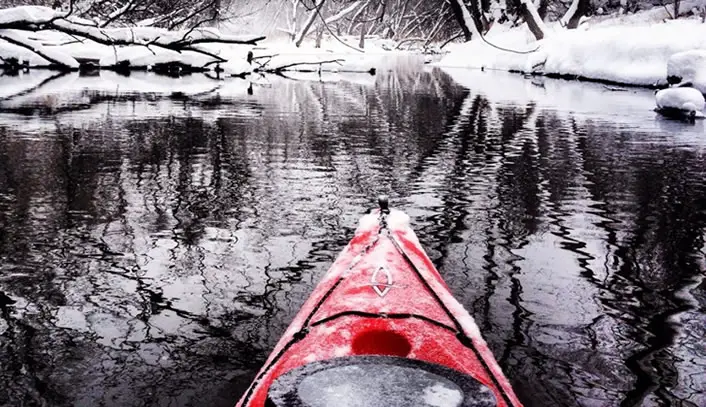
This easily forgettable membrane also keeps your body warm and dry, whilst you sit in your kayak.
A sprayskirt forms a seal around the neck of the cockpit of your boat and around your torso to provide an impermeable layer that keeps your legs and lower body free from water.
For more information on essential kayaking equipment that every kayaker should have read this.
12 Top Tips For Winter Kayaking
There are several things you can do to make your wintering kayaking a fun and safe activity.
However, according to many expert kayakers, the most important winter kayaking advice that anyone can give you is this:
Always operate well within your skill set.
The adverse conditions of winter should be a cause for pause and caution, rather than a catalyst to rush into the abandonment of adventure.
Here are a few tips to stay safe and have fun when winter kayaking:
- Ensure you have the correct kayak for the marine environment while also taking into consideration the season. A kayak that is perfect for summer waters may be unsuitable for the same waters in the winter.
- Ensure your gear is adequate for your winter kayaking needs.
- Wear a wetsuit next to your skin for protection against shock and hypothermia.
- Wear a drysuit over your clothing to keep you waterproof.
- Only tackle waters, and only paddle under conditions, that you have the skills to tackle.
- Stay warm by wearing layers.
- Stay hydrated with appropriate beverages and avoid drinks that dehydrate you.
- Keep energy bars close to hand to replenish your energy reserves.
- Give yourself extra time to reach your destination. It takes more effort and energy to paddle in the winter.
- Be sure you aware of the type of water you will encounter.
- Check the weather before you embark to ensure you will not run into trouble when out on the water.
- Be sure your kayaking skills are good enough for you to handle the water and the weather.
Summary: How To Kayak In Winter The Safe Way
Kayaking in the winter has its own unique benefits which other seasons just cannot offer:
- Winter water, and winter weather conditions, will help you hone your kayaking skills and give you a challenge you would not otherwise experience in other seasons.
- Winter scenery, on unoccupied waterways, can be truly breathtaking and the quiet and solitude (even when in a group) can be restorative to mind, body and soul.
But winter kayaking isn’t all fun. It comes also comes with its own unique challenges:
- Extreme cold air, and cold water conditions, can put a considerable strain on your body’s metabolism and heat regulatory functions.
- Fighting these conditions uses a lot of energy. In fact, activities that you perform easily when kayaking during milder temperatures require much more energy in colder temperatures and possibly more challenging waters.
- In the winter you run the risk of shock and hypothermia if you fall into freezing water.
To ensure you have a safe fun-filled kayaking trip it is advisable that you stick to the 4 golden rules:
- Check the weather and know the type of water you will encounter before you leave.
- Know the limits of your kayaking skills and don’t attempt a trip you don’t have the skill set for.
- Make sure you are using the correct kayak.
- Make sure you have the correct equipment, including protective clothing and gear.
Happy (and safe) winter kayaking!

